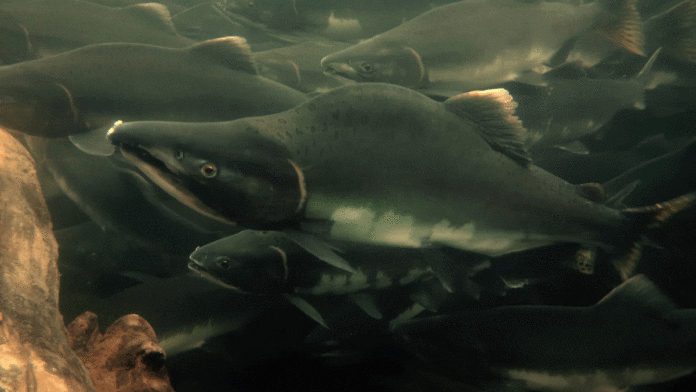Three new viruses, all related to other viruses that cause serious disease in other species, have been found in endangered Chinook and sockeye salmon, University of British Columbia researchers say in a new report published in the journal e-Life.
“These viruses have probably been circulating in salmon populations for a long time,” said Gideon Mordecai, a researcher at UBC’s Department of Earth, Ocean and Atmospheric Sciences. “They are new to science, but probably not to salmon.”
The collapse of keystone populations of sockeye and Chinook salmon in the Northeast Pacific is of great concern, and it is thought that infectious disease may contribute to declines but little is known about the viruses endemic to Pacific salmon, the researchers note.
The impact of these viruses on salmon health is not yet known.
The report published on Wednesday, Sept. 4, in e-Life said these findings will aid salmon conservation efforts by informing the extent to which these viruses are present in wild salmon populations. Future work will focus on determining the risks these viruses pose to salmon health and investigating the potential for exchange between hatchery, farmed and wild salmon populations, the report said.
“We were surprised to find viruses which had never before been shown to infect fish,” Mordecai said. “Although there’s no risk to humans, one of the viruses is evolutionarily related to respiratory coronaviruses and is localized to the gills. That suggests it has a similar infection strategy to its distant relatives that infect mammals.
UBC and Fisheries and Oceans Canada researchers used DNA sequencing followed by tests specific to each virus to screen over 6,000 salmon from along the B.C. coast, including wild, hatchery and aquaculture fish.
They found the new viruses widely distributed in dead and dying farmed salmon and in wild salmon. Those findings emphasize the potential role that viral disease may play in the population dynamics of wild fish stocks, and the threat that these viruses may pose to aquaculture, said UBC virologist Curtis Suttle.
One new virus, detected more commonly in salmon hatcheries, infected over 15 percent of all hatchery Chinook tested.
There are vaccines for other fish viruses and they can be very effective, but because these viruses have just been discovered, we are a long way from these kinds of interventions, Mordecai said.
“We do not even know yet if these viruses cause disease, so we will have to follow up on this too,” he said.
Another new virus was detected in 20 percent of adult or sub-adult Chinook from fish farms. In general, the new viruses were more commonly found in cultured fish populations than in the wild.
“It’s essential that we determine whether these viruses are important factors in the decline of Chinook and sockeye salmon stocks,” Suttle said. “The research highlights the need for robust surveillance to improve our understanding of how viruses might impact the health of wild Pacific salmon populations.”
How these particular viruses may have spread from other species to Chinook and sockeye salmon is uncertain. Researchers are working on screening of other species, “but something to bear in mind is that there are probably tens of thousands of different fish viruses, and we only know of a few hundred,” Mordecai said. “New technologies are enabling us to discover them at a faster and faster rate, but the challenge is working out if these viruses have any implications in the health of wild or cultured populations.”
“Being able to screen so man fish for these viruses was an exciting breakthrough and meant we were able to identify hotspots of infection,” he said. “One of the viruses was relatively common in juvenile migratory salmon as they enter the ocean – a period thought to be critical to their survival into adulthood.”
The research was funded as part of the Strategic Salmon Health Initiative, a partnership of Genome BC, Fisheries and Oceans Canada, and the Pacific Salmon Foundation.






